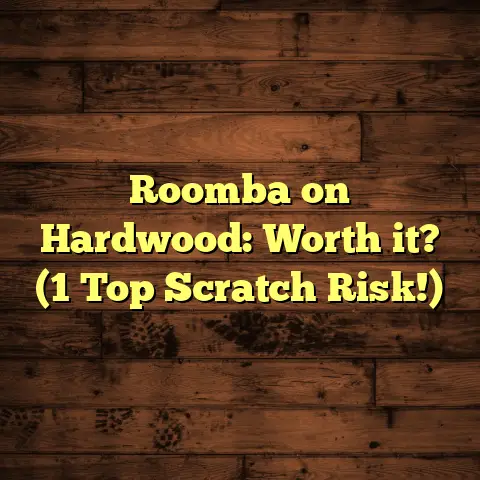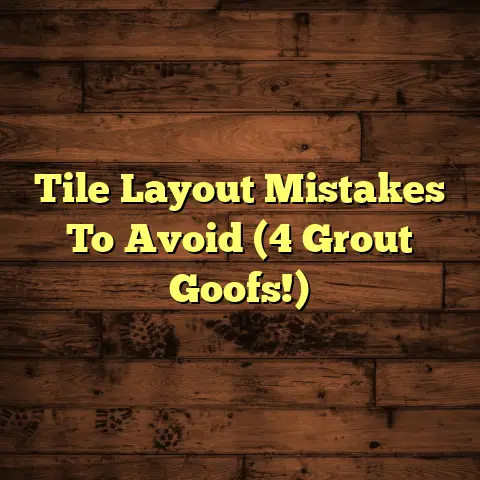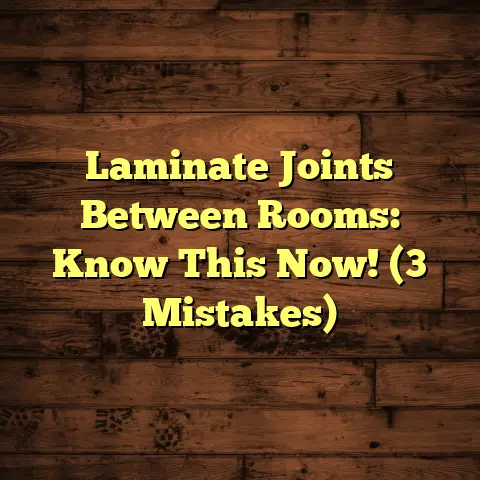Damp Proof Membrane: What Is It & Do You Need It? (1 Key?)
I’m Mike, a flooring contractor with over 20 years in the game. I’ve seen firsthand how moisture can destroy a beautiful home, and more importantly, how it can tank your property’s resale value.
Think about it: when you’re buying a house, you’re not just looking at the granite countertops and the updated appliances.
You’re also subconsciously (or consciously!) assessing the overall health and integrity of the structure.
And one of the biggest red flags for potential buyers? Dampness.
That’s where damp proof membranes (DPMs) come in. They’re like the unsung heroes of home construction, working tirelessly behind the scenes to protect your investment.
Let’s dive in and explore what DPMs are all about, why they matter, and whether you need one in your home.
Section 1: Understanding Damp Proof Membranes
So, what exactly is a damp proof membrane?
In simple terms, it’s a barrier designed to prevent moisture from rising through the floor and walls of your property.
Think of it like a raincoat for your building’s foundation.
Materials:
DPMs are typically made from waterproof materials like:
- Polyethylene: This is a common plastic material, often used in sheet form. It’s flexible, durable, and relatively inexpensive. I’ve used tons of polyethylene DPMs in my time.
- Bitumen: This is a tar-like substance that’s highly resistant to water. You’ll often find it in older homes or in situations where a more robust barrier is needed.
- Modified Bitumen: This is bitumen that’s been enhanced with polymers to improve its flexibility and durability.
Purpose:
The primary purpose of a DPM is to prevent capillary action, which is the process by which water is drawn upwards through porous materials like concrete.
Without a DPM, moisture from the ground can seep into your foundation, leading to dampness, mold growth, and structural damage.
Types of DPMs:
There are several types of DPMs available, each suited for different applications:
- Sheet Membranes: These are the most common type of DPM, typically made from polyethylene or modified bitumen. They’re installed as a continuous layer beneath the floor slab or within the walls.
- Liquid-Applied Membranes: These are applied as a liquid and then cure to form a waterproof barrier. They’re often used in areas with complex shapes or where it’s difficult to install a sheet membrane. I’ve used these in bathrooms or around pipes where cutting a sheet membrane would be difficult.
- Vertical DPMs: These are installed on the exterior of walls to prevent moisture from penetrating from the outside.
Section 2: The Importance of Damp Proof Membranes
Why should you care about a piece of plastic or tar buried beneath your floor?
Well, the importance of a DPM goes far beyond just keeping your feet dry.
Structural Integrity:
Dampness is a silent killer of buildings.
Over time, moisture can cause:
- Mold and Mildew: These fungi thrive in damp environments and can damage building materials like wood, drywall, and insulation.
- Rot: Wood rot can weaken structural timbers, making your home unsafe.
- Corrosion: Moisture can accelerate the corrosion of metal components like pipes and reinforcing steel.
- Efflorescence: This is the white, powdery deposit that can appear on walls and floors as water evaporates, leaving behind mineral salts. It’s a sign that moisture is migrating through the building materials.
A DPM prevents these problems by blocking the source of the moisture.
Health Implications:
Dampness isn’t just bad for your house; it’s bad for your health too.
- Respiratory Issues: Mold and mildew can release spores into the air, which can trigger asthma attacks and other respiratory problems. According to the EPA, mold exposure can cause a variety of health effects, including nasal stuffiness, throat irritation, coughing or wheezing, eye irritation, and skin irritation. (Source: https://www.epa.gov/mold/mold-and-health)
- Allergies: Mold and dust mites (which thrive in damp environments) are common allergens.
- Skin Irritation: Direct contact with mold can cause skin rashes and other irritations.
A healthy home is a dry home.
Resale Value:
Here’s where it all comes together. A home with damp issues is a hard sell.
Potential buyers will be turned off by the sight of mold, the smell of mildew, and the knowledge that there are underlying structural problems.
According to a study by the Royal Institution of Chartered Surveyors (RICS), properties with damp problems can lose up to 20% of their value. (Source: RICS Home Surveys)
A DPM is an investment that protects your property value.
Case Study:
I once worked on a house that had severe damp problems. The owners had ignored the issue for years, and by the time they decided to sell, the damage was extensive.
The floors were rotting, the walls were covered in mold, and the air smelled musty.
The house sat on the market for months with no offers. Eventually, the owners had to drop the price significantly to attract a buyer willing to take on the repairs.
If they had installed a DPM when the house was built, they could have avoided all of that hassle and expense.
Section 3: Assessing the Necessity of a Damp Proof Membrane
Okay, so DPMs are important. But do you really need one?
The answer depends on several factors:
Location:
- Proximity to Water Bodies: If your home is located near a river, lake, or ocean, it’s more likely to be exposed to high levels of groundwater.
- Soil Type: Clay soils retain more moisture than sandy soils, increasing the risk of dampness.
- Rainfall: Areas with high rainfall are more prone to damp problems.
Property Type:
- Older Homes: Older homes may not have a DPM, or the existing DPM may be damaged or ineffective. I’ve seen homes built before the 1950s with no DPM at all!
- Modern Constructions: Modern building codes typically require the installation of a DPM. However, it’s still important to ensure that the DPM is properly installed and maintained.
- Basements/Cellars: Basements and cellars are particularly vulnerable to dampness due to their location below ground level.
Current Condition:
- Signs of Dampness: Look for telltale signs
of dampness, such as:
- Musty odors
- Visible mold or mildew
- Water stains on walls or floors
- Peeling paint or wallpaper
- Efflorescence
- Condensation on windows or walls
- Rising Damp: This is a specific type of dampness that occurs when moisture rises up through the walls from the ground. It’s often characterized by a tide mark on the walls.
- Existing DPM: If your home already has a DPM, inspect it for damage or deterioration. Cracks, tears, or punctures can compromise its effectiveness.
How to Assess:
- Visual Inspection: Carefully inspect your home for the signs of dampness listed above. Pay particular attention to areas near the ground, such as basements, crawl spaces, and exterior walls.
- Moisture Meter: A moisture meter can be used to measure the moisture content of building materials. This can help you identify areas where moisture is present, even if there are no visible signs of dampness.
- Professional Inspection: If you’re unsure whether you need a DPM, it’s best to consult with a qualified building surveyor or damp proofing specialist. They can conduct a thorough inspection of your property and provide you with expert advice.
Section 4: Installing a Damp Proof Membrane
So, you’ve determined that you need a DPM. Now what?
You have two options: DIY or hire a professional.
If you’re a handy homeowner with experience in construction, you may be able to install a DPM yourself. However, it’s important to understand that this is a complex task that requires careful planning and execution.
If you’re not comfortable with DIY projects, it’s best to hire a professional damp proofing contractor.
DIY Installation:
Here’s a general outline of the process for installing a sheet membrane DPM:
Preparation:
- Assess the Area: Determine the size of the area that needs to be covered with the DPM.
- Gather Tools and Materials: You’ll need:
- DPM sheet (polyethylene or modified bitumen)
- Measuring tape
- Utility knife or scissors
- Seam tape or adhesive
- Gloves
- Safety glasses
- Prepare the Surface: Clean the surface to be covered with the DPM. Remove any debris, dirt, or loose materials.
Step-by-Step Installation:
- Cut the DPM: Measure and cut the DPM sheet to the required size. Allow for overlap at the seams.
- Lay the DPM: Position the DPM sheet over the area to be covered. Ensure that it’s properly aligned and that there are no wrinkles or creases.
- Seal the Seams: Overlap the edges of the DPM sheets by at least 150mm (6 inches). Seal the seams with seam tape or adhesive.
- Secure the DPM: Secure the DPM to the substrate with appropriate fasteners or adhesive.
- Protect the DPM: Cover the DPM with a protective layer of screed or concrete to prevent damage.
Common Pitfalls:
- Incorrect Material: Using the wrong type of DPM for the application.
- Poor Surface Preparation: Failing to properly clean and prepare the surface before installing the DPM.
- Inadequate Sealing: Not properly sealing the seams between the DPM sheets.
- Damage During Installation: Puncturing or tearing the DPM during installation.
Hiring a Professional:
If you decide to hire a professional, be sure to:
- Get Multiple Quotes: Obtain quotes from several different contractors.
- Check References: Ask for references from previous clients.
- Verify Credentials: Make sure the contractor is licensed and insured.
- Get a Written Contract: Ensure that the contract includes a detailed description of the work to be performed, the materials to be used, and the total cost.
Section 5: Maintenance and Longevity of Damp Proof Membranes
A DPM is not a “set it and forget it” solution.
To ensure its continued effectiveness, it’s important to maintain it properly.
Maintenance:
- Regular Inspections: Periodically inspect the DPM for signs of damage or deterioration.
- Prompt Repairs: Repair any damage to the DPM as soon as possible.
- Proper Drainage: Ensure that the area around your home has proper drainage to prevent water from pooling near the foundation.
Signs of Failure:
- Visible Dampness: The reappearance of dampness in areas that were previously dry.
- Mold Growth: The growth of mold or mildew on walls or floors.
- Musty Odors: A persistent musty odor in the home.
Lifespan:
The lifespan of a DPM depends on the material it’s made from and the conditions it’s exposed to.
- Polyethylene: Polyethylene DPMs typically last for 20-30 years.
- Bitumen: Bitumen DPMs can last for 30-50 years or more.
- Modified Bitumen: Modified bitumen DPMs offer improved durability and can last for 50 years or more.
Factors that can affect the lifespan of a DPM include:
- Sunlight Exposure: Prolonged exposure to sunlight can degrade the DPM.
- Physical Damage: Punctures, tears, or other physical damage can compromise the DPM’s effectiveness.
- Chemical Exposure: Exposure to certain chemicals can damage the DPM.
Section 6: The Financial Implications of Damp Proof Membranes
Let’s talk money.
Is installing a DPM worth the cost?
Cost Analysis:
The cost of installing a DPM varies depending on the size of the area to be covered, the type of DPM used, and whether you hire a professional or do it yourself.
- DIY Installation: The cost of materials for a DIY installation can range from \$0.50 to \$2.00 per square foot.
- Professional Installation: The cost of professional installation can range from \$3.00 to \$8.00 per square foot.
Increased Property Value:
As I mentioned earlier, properties with damp problems can lose up to 20% of their value.
Installing a DPM can prevent dampness and protect your property value.
Example:
Let’s say your home is worth \$500,000. If it has damp problems, its value could decrease by \$100,000.
Installing a DPM for \$5,000 could prevent that loss and potentially even increase the value of your home.
Decreased Resale Value:
Failing to address damp issues can lead to:
- Lower Offers: Potential buyers will likely offer less for a home with damp problems.
- Contingencies: Buyers may include contingencies in their offers that require you to fix the damp problems before the sale can close.
- Lost Sales: Some buyers may simply walk away from the deal if they’re not comfortable with the damp issues.
Section 7: Expert Opinions and Industry Standards
I’m not the only one who thinks DPMs are important.
Here’s what other experts have to say:
- Construction Experts: “A damp proof membrane is an essential component of any building structure. It protects the building from moisture damage and helps to ensure its longevity.”
- Real Estate Agents: “Dampness is one of the biggest turnoffs for potential buyers. A home with a properly installed DPM is much more attractive to buyers and will likely sell for a higher price.”
- Home Inspectors: “I always check for signs of dampness during a home inspection. If I find any evidence of dampness, I recommend that the buyer have a professional damp proofing inspection.”
Industry Standards:
Building codes and industry standards typically require the installation of a DPM in new constructions.
The specific requirements vary depending on the location and the type of building.
In the United States, the International Building Code (IBC) provides guidelines for damp proofing and waterproofing.
Conclusion
So, there you have it.
Damp proof membranes are a critical component of any building structure. They protect your home from moisture damage, prevent health problems, and safeguard your property value.
If you’re not sure whether you need a DPM, I encourage you to consult with a qualified building surveyor or damp proofing specialist.
It’s an investment that’s well worth making.
Don’t wait until it’s too late. Protect your home and your investment with a damp proof membrane.
Thanks for reading! I hope this article has been helpful. If you have any questions, feel free to leave a comment below.
Happy building!





